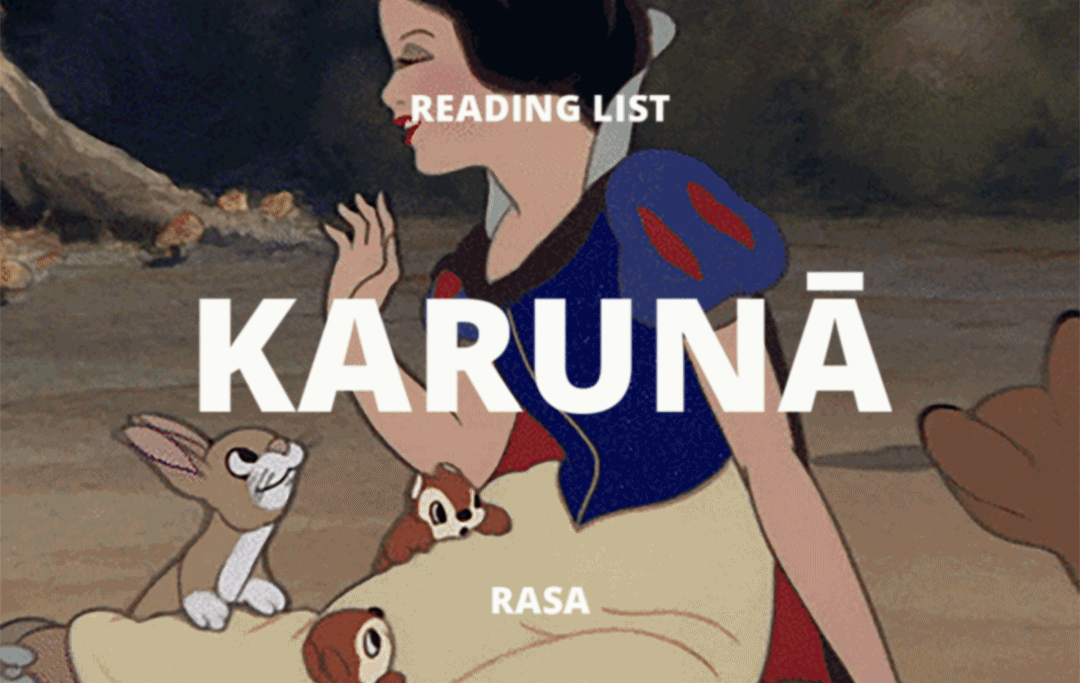-
Our monthly stories are productions looking to connect people to the magic of stories.
We create supplementary reading lists as a way to give you an insight into the inspirations and thinking behind our monthly stories. These reading lists take you behind the story, revealing the process of its making.
-

Rasa → Kāruṇyam (कारुण्यं): Compassion, mercy. Presiding deity: Yama. Colour: grey, Adbhutam (अद्भुतं): Wonder, amazement. Presiding deity: Brahma. Colour: yellow
-
Archetype → Magicien
-
-
“I’ve learned that people will forget what you said, people will forget what you did, but people will never forget how you made them feel,” said Maya Angelou. Emotions are the first language. They are our most natural bridge to connect with another. Our understanding of other people is very much connected to our ability to observe, analyze and mirror others’ emotions—a very natural process for us humans who are inherently social creatures. Reaching consensus, communicating needs and sharing ideas, and experiences through empathy is our natural habitat.
Scientists now know that this capacity for empathy requires an exquisite interplay of neural networks enabling us to perceive the emotions of others, resonate with them emotionally and cognitively, to take in their perspectives, and to distinguish it with our own. In the eastern artistic theory of Rasa, compassion (karunā rasa) is an emotional state that often leads to creating empathy. Wrongs that right injustice, worldly sorrows weighing down a young person, longing for life’s dreams are compassion evoking themes that we used in this monthly story to induce empathy towards a morally compromising act. The main character of this story, Kusum, was built using the shadow side of the character archetype magician—the manipulator.
In this reading list, you’ll find stories, books, films, and research that connects to compassion, finding emotional empathy in moments that conflict with the cognitive and the magician archetype from Jungian psychology.
1994, I.A. Richards and Indian Theory of Rasa, Gupteshwar Prasad. Sarup & Sons, New Delhi, India. Page 24: This book details the rasa theory with parallels to other theories connecting to the arts and their enjoyment. Gupteshwar notes how being affected by others’ emotions is the primary condition of aesthetic enjoyment. He points to this impersonal identification of emotions as an extension of the ‘karuna rasa’, which is called ‘samvēdhana’ in the original rasa theory, and says it’s the same as what’s knowns as ‘empathy’ in English and ‘einfuhlung’ in German.
2016, Mind and creativity: Insights from rasa theory with special focus on sahrdaya (the appreciative critic). Louise Sundararajan, Maharaj K. Raina. The Sage Pub: Rasa theory suggests that there are three aspects or stages to art: the first is the creative process of the artist; the second is the artwork; and the third is the viewer’s response—when the artist’s experience is recreated through empathy. It further details Tādātmya—a state of the reader or spectator who loses for a while his or her personal self-consciousness and identifies him or herself with some character in the story or scene.
Saradiel is a man who lived in Mawanella, Sri Lanka in the 19th century and was executed for theft and murder. Saradiel’s image is conflicting. Bandit, vigilante, people’s champion, lawbreaker, murderer, hero of the poor….it’s not easy to fit him into one box. Saradiel’s targets were mostly the rich aristocracy and colonial officials; he robbed, killed, and intimidated many. At the same time, he selflessly shared his loot with the poor and fought against injustices that they suffered at the hands of the rich and the powerful. He is sometimes listed among national heroes. But, he is also marked as a dangerous criminal. Despite the sticky image, people still visit his last jail cell, and his tales have been made into many books, films and tele dramas. Saradiel certainly occupies that difficult space between hero and outlaw. In Saradiel’s stories, we see how a criminal by law is capable of evoking empathy even in usually law-abiding people.
When Carl Jung first identified the ‘Magician’ archetype, he called it the Philemon. In his Liber Secundus we are introduced to Philemon, the ‘magician’. On the nature of magic Jung derived from Philemon he has written, “there is nothing to understand…Magic happens to be everything that eludes comprehension.” The difficulty with magic is precisely the difficulty of existing without reason. The foundation responsible for bringing Carl Jung’s works to the world is called the Philemon Foundation after this archetype that deeply influenced Jung.
The antihero is a character type that blurs the line between good and evil, and achieves a justified cause in their own way, often questioning morality. They are morally ambiguous and lack conventional heroic attributes. Unlike the ‘hero’—who is an idealized, flawless personality—the ‘anti-hero’ is more human and relatable to the average person, evoking their compassion and empathy.
Lestat de Lioncourt (The Vampire Chronicles)
Man with no name (The Dollars trilogy)
Nancy Botwin (Weeds)
2009, Royal, Warrior, Magician, Lover—Archetypal reflectivity and the construction of professional knowledge. Darrell Dobson, Teacher Education Quarterly (Pages 154-157): Dobson identifies the magician archetype as one that actively seeks to put that content and methodological knowledge in service to the fullest possible individual and social development every day, and recognizes that such a practice derives from and will provide encounters with the numinous, whether in mathematics, science or art. He identifies the active shadow magician is the manipulator—who has either not mastered his technologies or himself, or both.
2012, “Rasa Yatra” — Using film to teach cross-cultural empathy, Martin Haigh, Planet, 26:1, 51-58: Empathy is a key skill for intercultural understanding. This paper evaluates the results of a pilot study for an exercise designed to introduce undergraduate geographers to the problems of interpreting emotional messages from an unfamiliar culture and worldview. Learners are set the task of interpreting the emotional content of this film and of trying to share the feelings of another.
